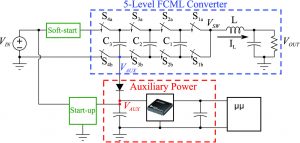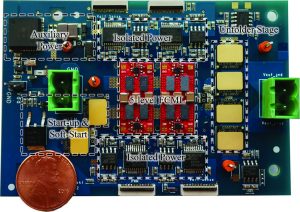A Five-Level Flying Capacitor Multi-Level Converter with Integrated Auxiliary Supply and Start-Up
PhD student Andrew Stillwell with advisor R. Pilawa-Podgurski
Flying capacitor multi-level (FCML) converters are capacitor-baser power converters that provide high-density and high-efficiency power conversion for dc-dc and dc-ac applications. In many of these applications, there is a need for an auxiliary power supply for control, thermal management, or secondary loads. This auxiliary supply is traditionally sourced from the high-voltage input (which necessitates high voltage and thus large volume) or the output (which creates start-up issues). Due to the multi-level nature of the FCML converter, there exists a naturally occurring, low-voltage node that enables a compact and highly efficient auxiliary power supply sourced from within the FCML converter, as shown in Figure 20. However, sourcing power from this node disrupts the natural balancing of the flying capacitors, which detrimentally increases the switch voltage rating and the capacitor voltage rating. To compensate for the current sourced to the auxiliary converter, we apply active balancing through feedback and duty-cycle adjustments. This concept was proven with a hardware prototype, shown in Figure 21, and demonstrated excellent flying capacitor balancing.
An additional challenges in these applications is meeting the start-up requirements. For a stand-alone converter, the start-up circuitry must power the control and gate-driving circuits until the auxiliary power converter can supply the power. The start-up circuit must soft-start the FCML converter to prevent damage to the device components, in particular the switches, which are typically rated for a fraction of the input voltage. This work, supported by the Army Research Laboratory, presents a start-up circuit that supplies power directly to the auxiliary power converter, as shown in Figure 20, rather than directly to the controller and gate drivers. The scheme reduces the voltage step-down requirements of the start-up power supply, which yields an increase in efficiency and in turn a reduction in size of the start-up circuitry heat-sink. In addition, the solution reduces the supply current requirements while reusing existing auxiliary supply components.

